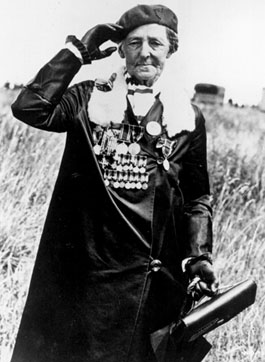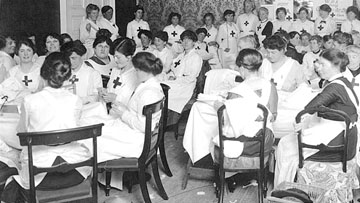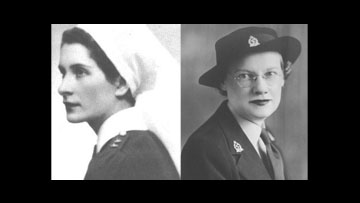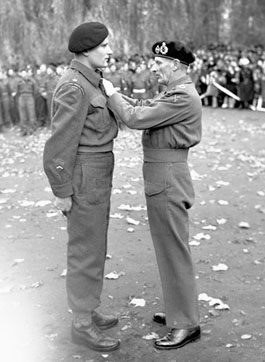Canada Remembers Times - 2016 Edition - Page 3
Brothers in arms
Military Cross.
(Photo: Veterans Affairs Canada)
Approximately 4,000 Indigenous soldiers served valiantly in the First World War, and at least 50 received medals for bravery on the battlefield. Many excelled as scouts and snipers, due to their hunting and wilderness skills.
Two brothers from the Six Nations Cayuga band in Ontario, Alexander and Charles Smith, enlisted three months after the outbreak of the First World War. Both had previous militia training and were commissioned as officers.
In September 1916, Alexander earned the Military Cross during the Battle of the Somme, in France. He helped capture an enemy trench and 50 prisoners, despite being buried twice by dirt from exploding shells. Charles earned the Military Cross in France on November 9, 1918, two days before the war ended. He and his platoon stopped enemy sappers preparing to blow up a road mine and, later that day, captured a machine-gun position.
The Smith brothers returned to Canada after the war, fine examples of the courage shown by so many Indigenous warriors.
A heavy cross to bear
Charlotte Wood at Vimy Ridge in 1936.
(Photo: Library and Archives Canada PA-148875)
The Memorial Cross (or Silver Cross as it is also known) was established as a memento for family members of those who died in military service. Sadly, tens of thousands have worn the Silver Cross since the end of the First World War. It is a medal that no one hopes to receive, but for those who lost a loved one, it’s a special way to share their grief, while also showing their pride.
In 1936, many Canadian mothers made a pilgrimage to France for the unveiling of the Vimy Memorial. Among them was Charlotte Wood, from Winnipeg, who lost two sons in the war. She became the first National Silver Cross mother and the tradition continues today. Every Remembrance Day, the Royal Canadian Legion selects a mother to lay a wreath at the National War Memorial in Ottawa to represent all those who lost a son or daughter.
When we remember those who gave their lives, let’s not forget that for each of them there is a family that also feels the pain of war.
Busy fingers on the home front
Women knitting socks for Newfoundland soldiers in 1915.
(Courtesy of The Rooms Provincial Archives Division B 5-173)
Thousands of Newfoundlanders enlisted during the First World War. The women of Newfoundland also wanted to contribute to the war effort and started the Women’s Patriotic Association. They knit tens of thousands of wool socks, gloves and scarves for their sons and other soldiers serving overseas. The women were very proud yet worried about their boys and wanted to make sure they were getting some comforts from home.
Sometimes, women wrote short notes such as “into this sock I weave a prayer.” Occasionally, soldiers would write back and some even developed romantic relationships when they returned home!
For the Newfoundlanders in the cold trenches, the gifts from home reminded them that they were still tightly knit with the island they had left behind.
The Olympic-military connection
Steve Daniel at the 2008 Summer Paralympic Games in Beijing.
(Photo: Canadian Paralympic Committee)
Did you know that there is a long relationship between sports and military service in our country? Tom Longboat, Percival Molson, Jack Varaleau, Ken Money, Mark Graham and Sharon Donnelly are just some of the Canadian athletes who have proudly worn both a military uniform and an Olympic uniform over the years.
Steve Daniel, of Ontario, is a Veteran of peace support missions in Bosnia, Croatia and Afghanistan. Unfortunately he suffered a spinal injury during a parachute training jump in 2005 and was paralysed from the waist down. After rehabilitation, Daniel took up arms-only rowing and quickly rose to an elite level. He went on to compete in rowing at the 2008 Summer Paralympic Games.
The peace and freedom we in Canada enjoy today is only a dream in many of the countries that compete in these international games. To learn more about Canadian Olympians who served in uniform, visit the Olympics web feature.
POW Nursing Sisters
Kathleen Christie (L) and Anna May Waters (R)
(Photos: Bay Chaleur Military Museum, Quebec)
Kathleen Christie of Toronto, and Anna May Waters of Winnipeg served as Nursing Sisters during the Second World War. They sailed with Force C to Hong Kong in October 1941.
When the Japanese captured Hong Kong, Christie and Waters were looking after the wounded in a British military hospital. The staff became prisoners of war (POWs) and endured lack of food, scarce medical supplies and harsh treatment by their captors. Typhus, tuberculosis, malaria and vitamin deficiency took a great toll.
The Nursing Sisters’ skills helped many of the sick soldiers survive. These brave women stayed with the wounded Canadian men, working under atrocious conditions until they were finally forced to move into a civilian internment camp.
After two hard years in captivity, Christie and Waters returned to Canada in a prisoner exchange, the first members of Force C to return home.
Canadian tank ace
Major Radley-Walters receiving the Military Cross in Belgium in 1944.
(Photo: Library and Archives PA-128092)
Very few Canadians have had their names used as an award in the gaming world, but most people don’t have the military achievements of tank ace Sydney Radley-Walters!
Born in 1920 in Québec, Radley- Walters studied science and played football at Bishop’s University. During the Second World War, he joined the Sherbrooke Fusiliers Regiment in 1940. The unit was made up of French and English speaking volunteers and became the 27th Canadian Armoured Regiment.
Their baptism of fire was on June 7, 1944, the day after the Normandy landings. Radley-Walters was quick to strike, destroying a German tank on that day. The young commander was a gifted tactician and he would exploit weaknesses in German tanks, concentrating fire at the base of the turret to knock them off. To improve his own tanks’ protection, he encouraged his men to weld used tank tracks to the base of their own turrets and put sandbags on the thin floor of their vehicles, to absorb the force of a mine explosion.
Radley-Walters always insisted on the importance of preparing his soldiers well. He led from the front, his tank in the middle of the action. He and his crew would be credited with a remarkable total of 18 victories during fighting in Normandy, the Netherlands and Germany. Radley-Walters remained in the Army until 1974, retiring with the rank of Brigadier-General. He passed away in April 2015, but his memory lives on with his family and friends, and in a well-known tank video game.
- Date modified:





